
Edward Bernays may be known as the Father of Public Relations, but you would not be mistaken if you thought of him as the Father of Lies. He was a bullshit artist par excellence who pioneered countless methods of deceiving the public.
For Bernays—author of mind-control manuals like Propaganda and The Engineering of Consent—there was no truth, no concept of an objective right or wrong. There were only wants, needs and desires. From advertising cigarettes to overthrowing governments—anything was possible. In his autobiography, Biography of an Idea: Memoirs of a Public Relations Counsel, Bernays borrowed a quote from a friend to describe this post-truth reality: “The cure for propaganda is more propaganda.” [1]

Big Tobacco
Bernays understood the truth is malleable based on an individual’s needs. People are not purely rational actors. They make choices contrary to their self-interest, ignore facts they find inconvenient, and avoid information that may damage their ego. The nephew of famed psychoanalyst Sigmund Freud, Bernays drew on Freud’s work into the unconscious mind to construct elaborate public relations campaigns that preyed on these tendencies. His preferred tactic? The astroturf campaign—which gave off the illusion of having grass-roots support.
Today, Bernays is best remembered for a series of ads and media events dubbed “Torches of Freedom,” an early venture into social marketing that turned smoking into a form of gendered rebellion, but his first position in Big Tobacco was far more prescient of a future spent manipulating the public.
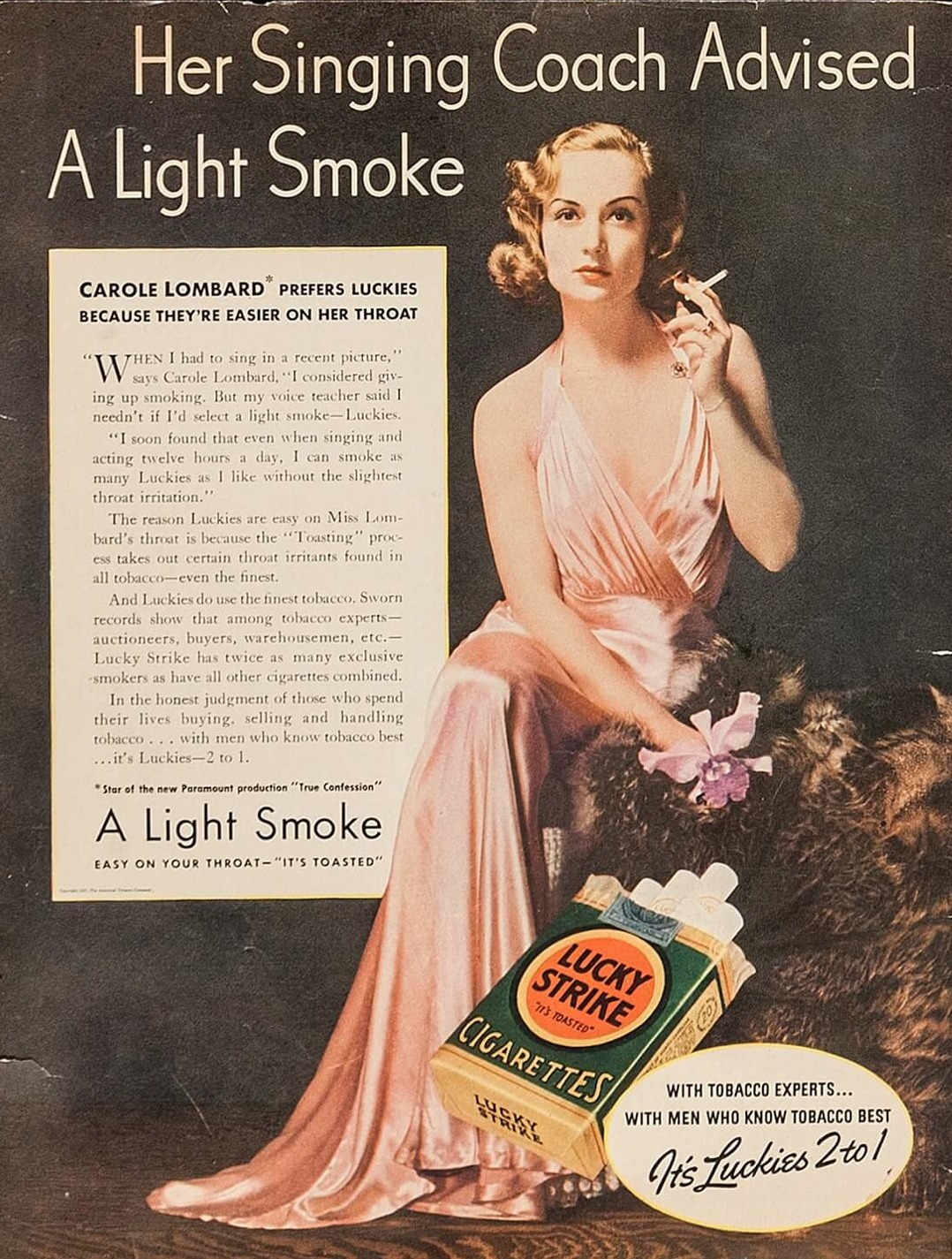

Working for Liggett & Myers, Bernays established a fake pressure group called the Tobacco Society for Voice Culture and blitzed letters to the editor to influential newspapers under an assumed identity. [2] The letters attacked claims made in ads for cigarette brand Lucky Strike that stated the cigarette helped singers overcome, as Lucky owners American Tobacco put it, “voice irritation.” Bernays’s campaign resonated to such a degree that The New Yorker ran a profile in which it interviewed the group’s “sole member” Henry Bern, a Bern-ays patsy. [3]
Bernays sought to exploit the gap between what the media report and what the public hears and, though his ideas were not always immediately successful, they would blossom strange fruit for decades to come.
In one of his more ambitious proposals, he called for American Tobacco (now his employers thanks to the success of the Liggett & Myers campaign) to create a front group that could anonymously promote its interests. This fake news group, the Tobacco Information Service Bureau (TISB), would send made-up press releases and articles to newspapers and magazines to create the illusion of a legitimate news bureau. [4]
One of the examples of an intended Bernays pitch highlights the absurdity of the TISB: “DOCTORS SAY CIGARETTES REDUCE NUMBER OF MOUTH BACTERIA.” [5] Although American Tobacco never implemented the suggestion, this would not be the end of Bernays’s infatuation with fake news.
The United Fruit Company
By 1950, the United Fruit Company had a problem. Guatemala, the source of its largest cash crop, was in the midst of a protracted revolution.
For most of the 20th century Guatemalans had lived under the authoritarian rule of American agribusiness. The United States government propped up successive Guatemalan dictators in exchange for the right of American companies to establish plantations in the country. Working conditions on these plantations were harsh—but worse still was the Guatemalan government’s clear favoritism toward American business owners.
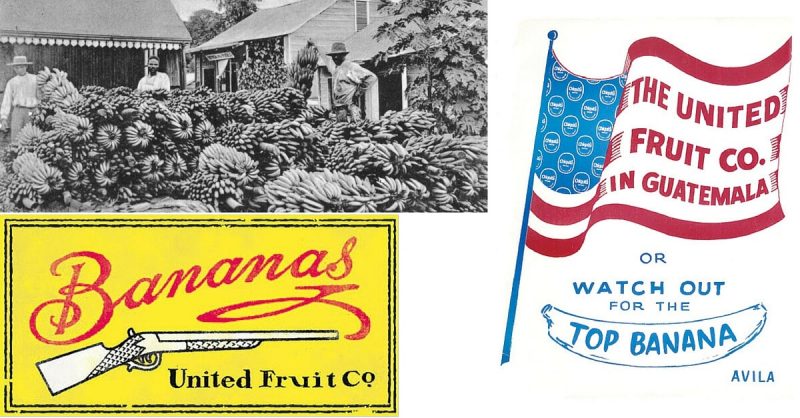
In 1936, for example, then-President Jorge Ubico negotiated a deal with United Fruit exempting it from most export taxes. Resentment built among Guatemalans until 1944, when student protests at the Universidad de San Carlos de Guatemala spiraled into a general strike.
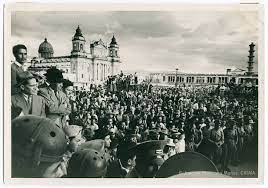
July 1944 general strike in Guatemala. [Source: facebook.com] 
Jorge Ubico [Source: wikipedia.org]
It was clear to United Fruit’s leadership, in particular company president Sam Zemurray, that the country was moving left. Guatemalan military leaders confirmed these fears in October 1944 when they overthrew the Ubico government, in what came to be known as the October Revolution. In the aftermath, Guatemala elected “spiritual socialist” Juan José Arévalo as its new leader. United Fruit needed something—or someone—to save its business.

It should come as no surprise that Sam Zemurray sought out the services of Edward Bernays. In the wake of Arévalo’s ascendance, Guatemala continued to experience political turmoil.
Between 1945 and 1951, there were anywhere from 25 to 30 coup attempts against the Arévalo government. [6]

Bernays was not troubled by this violence. In fact, he found a use for it. His strategy in Guatemala would be simple: He would encourage further unrest. His goal, as described in Biography of an Idea, was to help the public “learn more about the countries in which [United Fruit] functioned and what social, economic, or other purposes it fulfilled.” [7]

But this would be no innocent public relations campaign. Bernays, the Father of Lies, went back to his time in the tobacco industry to pull from his bag of tricks.
The Middle American Information Bureau
Established in 1943, the Middle America Information Bureau (MAIB) served, by Bernays’s estimate, 25,000 Americans working in the media. [8] The organization spun events in Central America through the filter of United Fruit’s economic and political goals, providing American journalists and opinion leaders with United Fruit-approved context.
In the run-up to the 1945 Guatemalan revolution, for example, the MAIB published a pamphlet titled “Every American has a personal stake in our relations with Middle America.” It collated pull quotes from military leaders, business executives, and government officials explaining the “interdependence of Middle America and the United States.” [9]

The MAIB was part of a much larger infrastructure Bernays and Zemurray had set up to dupe the public. The phrase “Middle America,” an attempt by the two at rebranding Central America, came from the Middle American Research Institute (MARI), a Zemurray-funded research group at Tulane University. [10]
Zemurray had established MARI with the intention of focusing on the cultural history of Mexico but, over time, its focus shifted to include countries colonized by United Fruit. Bernays found this of particular importance in his goal of deposing the Guatemalan government.
He could use the patina of respectability provided by MARI to lend his new front an air of legitimacy. “Within a year authoritative atlases used the name Middle America to describe the territory in which the company was active,” he wrote in Biography of an Idea. “We were succeeding in equating the company with the area in which it functioned.” [11]
This infrastructure would expand over the course of the 1940s and 1950s. What was once a simple front operating as a news bureau grew into a propaganda machine that oversaw company newsletters in multiple Central American countries. [12]
At least one of the United Fruit-affiliated newsletters, Latin American Report, was later found to have CIA connections through its editor William Gaudet, whom the agency supported by paying for more than 20 subscriptions a year. [13]

It is unclear what Bernays’s level of knowledge was regarding Gaudet and his association with the CIA. An FBI memorandum dated June 28, 1968, noted that United Fruit officials viewed Gaudet as suspect due to various threats he had leveled at the company in the past. [14]
By that point, however, Gaudet and United Fruit had a collaborative relationship dating back more than a decade, based on articles and advertisements found in Latin American Report. [15] Does this mean the CIA was backing Bernays and his plan to topple the Guatemalan government?
Bernays Tricks a Nation
Bernays was an innovator in that he did not need to rely on others. By the time he felt he had exhausted all possibilities at diplomacy with the Guatemalan government, in 1950, he already knew how he intended to agitate his coup.
Arévalo’s successor, Jacobo Árbenz, was promising agrarian reforms that would return land from American businesses to the Guatemalan people.

Bernays surmised he could use this land-back promise to convince Americans that Árbenz was a threat not only to United Fruit but to the United States as well.
If Bernays could brand Árbenz a communist, he could inflate the threat posed in Guatemala. This would not be difficult, as he already believed Árbenz sympathetic to the communist cause. Writing in Biography of an Idea, he argued the Guatemalan leader “considered the anti-Communist movement subversive and openly accepted the Reds as allies.” [16]
A coup, however, required the full support of both the government and United Fruit, and United Fruit’s problem was that, to Bernays’s mind, its campaign against Guatemala was not aggressive enough. Sam Zemurray, United Fruit’s president, was well aware of the company’s image among American liberals as an aggressor in Central America and he had gone to great pains to rehab it.

An open coup could hurt business. So, in January 1950, when liberal magazine The Nation published “Democracy in Latin America: Chaos on Our Doorstep” attacking United Fruit’s exploitation of countries like Guatemala, it came as a shock to Zemurray. Zemurray was an avid reader of the magazine and took its positions as a bellwether on public opinion. The article threatened the reformed image that Zemurray had spent years cultivating. He endeavored to pen a response. Bernays, ever the opportunist, jumped into action.
Bernays knew that for a coup to take place he would have to appeal not only to United Fruit but also its well-intentioned liberal critics. Thus, on March 18th, a week before Zemurray’s letter was set to appear in The Nation, the magazine published “Communism in the Caribbean?” an article by a pseudonymous American writer identified as Ellis Ogle. The article was an about-face and made the case for a military intervention from a liberal perspective, with Ogle attacking Guatemala’s “free election” and lamenting that “foreigners have no votes in Guatemala.” [17]
Bernays could not have been happier. “I proposed sending the Nation article to 100,000 liberals,” he wrote in Biography of an Idea. “I believed the Caribbean ferment was bound to become increasingly important. Liberals must play a decisive role. Zemurray agreed.” [18]
What role did Bernays play in the writing of The Nation article? He had, in the past, written letters to publications using pseudonyms, as in the case of the Tobacco Society for Voice Culture. On the other hand, someone identifying as either a real or pseudonymous Ellis Ogle had appeared once before in the pages of The Nation—but that Ellis Ogle was no journalist and certainly not one stationed in Central America.
That Ellis Ogle appeared in a 1920 letter-to-the-editor chastising the Boston Evening Transcript for its labor coverage. [19]
One final wrinkle: The CIA first authorized William Gaudet to begin receiving payments for “special reports” in 1950. [20] The same FBI case file that contained the earlier 1968 United Fruit memorandum also observed that he “may do some free-lance writing under a pen name.” [21]
Regardless of who wrote the article, it achieved its intended effect. Zemurray appeared happy with its influence and started providing direct financial support to The Nation the following year. [22]
Bernays, having removed his final obstacle to a coup, began organizing trips to Guatemala for reporters. Beginning with New York Times writers Will Lissner and Crede Calhoun, Bernays instigated a press panic with carefully curated tours highlighting the dangers of the Árbenz government. [23]

These Bernays-sponsored trips coincided with violent protests, helping to shape perception of Árbenz as a power-hungry dictator. Ludwell Denny, foreign editor for Scripps Howard Newspapers, summed up this sentiment best in a February 1952 syndicated story comparing an alleged alliance between “Guatemalan National Socialists” and Moscow to the Molotov-Ribbentrop Pact. [24]

Once again, as with his prior stunts, Bernays’s media blitz worked. The incoming Eisenhower administration—which included Secretary of State John Foster Dulles, a partner at the law firm which had helped United Fruit negotiate the 1936 tax-dodging contract with Jorge Ubico—was open to the idea of a coup. [25]
Thus, in August 1953, President Eisenhower authorized the Central Intelligence Agency to undertake a covert operation to topple Árbenz.

Operation PBSuccess
Code-named Operation PBSuccess, the CIA operation lasted almost a year and consisted of psychological warfare designed to break the will of the Guatemalan people. Although Bernays was not directly involved, the CIA took a cue from the PR guru and flooded Guatemalans with propaganda to counter the Árbenz government’s own messages, the most notorious example being a fake radio station named the Voice of Liberation.
The station, directed by agent and ex-actor David Atlee Philllips, broadcast messages ranging from fake bulletins on troop movements to disinformation intended to stir hysteria and sow confusion among Guatemala’s citizens. One such broadcast: “It is not true that the waters of Lake Atitlan have been poisoned.” [26]


If Bernays could not take part in the coup in person, he was there in spirit because, on June 27, 1954, he achieved what no PR professional had before him. In the late hours of the evening a pre-recorded broadcast went out to the Guatemalan people. “Workers, peasants, patriots,” intoned the voice of Jacobo Árbenz. “Guatemala is going through a hard trial. A cruel war against Guatemala has been unleashed. The United Fruit Company and U.S. monopolies, together with U.S. ruling circles, are responsible for…” [27]
Jacobo Árbenz had resigned as president. Árbenz ended the broadcast by declaring, “Long live Guatemala!” but this sentiment would be short lived. After a series of political maneuvers, exiled military leader Carlos Castillo Armas returned to Guatemala and took power with the full support of the United States government. Guatemala backslid into authoritarian rule and the Castillo Armas government established concentration camps for political prisoners, where they executed suspected communists. [28]

Bernays, for his part, was ambivalent about his involvement in the coup. In his war on the truth, he had somehow lost sight of his role in fomenting unrest and convinced himself that he was the real victim. “I, too, became a casualty of this revolution,” he wrote, reflecting on his time lobbying against Guatemala. “[United Fruit’s public relations director] sent me a note telling me I was so well off economically that I didn’t need the United Fruit Company as a client.” [29]
The Father of Lies
Whether selling cigarettes or deposing world leaders, Edward Bernays molded reality like clay. In his hands, words spun like so many hollow jars. However, the one constant, the one truth among his many distortions, is that Bernays had no use for the truth.
In this sense, Bernays is responsible for our current information crisis. His public relations campaigns formed the foundation of modern disinformation and influence operations. You are not really lying if the lies you tell are to counter other lies. The cure for propaganda is more propaganda.
We can see the influence of Bernays today all around us, in politics and beyond. Dark money networks birthing artificial advocacy organizations, shadowy donors funding fake pressure groups. Bernays’s specter illuminates the television, where think tanks assemble pundits on the factory line. But most of all, we see him on social media platforms, spaces reliant on a kind of emotional manipulation Bernays perfected a century before Facebook and Cambridge Analytica existed.

Astroturfing is now the primary tool of political deception online. Militaries and police departments operate under fake identities; politicians maintain burner accounts; and government agencies direct troll armies.
If the 20th century was the century of the self, then the 21st is the century of the second self—of the third, the fourth, and the fifth. We are no longer bound by the constraints of the truth; as with Bernays, we are free to create and assume identities as we desire. Will we use this freedom to topple governments? Who has already?
Edward Bernays: The father of public relations, the father of lies.

[1] Edward Bernays, Biography of an Idea: Memoirs of a Public Relations Counsel (New York: Simon & Schuster, 1965), 384.
[2] Larry Tye, The Father of Spin: Edward L. Bernays & the Birth of Public Relations (New York: Crown Publishers, 1998), 35-36.
[3] Josef Israels and James Thurber, “The Talk of the Town”, The New Yorker, December 23, 1927, https://www.newyorker.com/magazine/1927/12/31/a-roland-for-an-oliver.
[4] Allan M. Brandt, The Cigarette Century (New York: Basic Books, 2007), 81-82.
[5] Ibid.
[6] Richard H. Immerman, The CIA in Guatemala: The Foreign Policy of Intervention (Austin, TX: University of Texas Press, 1982), 57; Jim Handy, “The Guatemalan Revolution and Civil Rights: Presidential Elections and the Judicial Process under Juan José Arévalo and Jacobo Arbenz Guzmán,” Canadian Journal of Latin American and Caribbean Studies, 10, no. 19 (1985): 7.
[7] Edward Bernays, Biography of an Idea, 749.
[8] Ibid.
[9] Middle America Information Bureau, Every American has a personal stake in our relations with Middle America (New York: Middle America Information Bureau, 1945), 4, https://babel.hathitrust.org/cgi/pt?id=nnc2.ark:/13960/t0vq8b37p&view=1up&seq=1&skin=2021.
[10] Edward Bernays, Biography of an Idea, 749.
[11] Ibid., 749-750.
[12] Stephen Schlesinger and Stephen Kinzer, Bitter Fruit: The Untold Story of the American Coup in Guatemala (Garden City, NY: Doubleday, 1982), 82.
[13] Ibid. See also U.S. Congress, House Select Committee on Assassinations, 1975, “Memo of Conversation Between George Gaudet and Bernard Festerwald,” Unclassified Memorandum, Washington, D.C.: United States House of Representatives, https://www.archives.gov/files/research/jfk/releases/180-10112-10390.pdf.
[14] SAC New Orleans, “Reurlet of 6/14/68” (Federal Bureau of Investigation, New Oleans, LA: June 28, 1968), 2, https://www.archives.gov/files/research/jfk/releases/docid-32298962.pdf.
[15] William George Gaudet, “The Bounding Main…”, Latin American Report, 1, no. 8 (1956): 3; United Fruit Company, “Seven to One,” Latin American Report, 3, no. 4 (1959): 1; United Fruit Company, “United Fruit Is Growing With Jamaica and Helping Jamaica to Grow,” Latin American Report, 5, vol. 3 (1963): 8.
[16] Edward Bernays, Biography of an Idea, 762.
[17] Ellis Ogle, “Communism in the Caribbean?” The Nation, March 18, 1950, 246-247.
[18] Edward Bernays, Biography of an Idea, 759.
[19] Ellis Ogle, letter to the editor, The Nation, July 10, 1920, 44.
[20] Raymond Reardon, “Subject: William George Gaudet” (Security Analysis Group, Washington, DC: January 16, 1976), https://documents.theblackvault.com/documents/jfk/NARA-Oct2017/NARA-Nov9-2017/104-10133-10236.pdf. [NOTE: Shouldn’t it state that it is a “CIA Routing and Record Sheet” somewhere?]
[21] SAC New Orleans, “Reurlet of 6/14/68,” 3.
[22] Dan Koeppel, Banana: The Fate of the Fruit That Changed The World (New York: Hudson Street Press, 2008), 119.
[23] Will Lissner, “Soviet Agents Plotting to Ruin Unity, Defenses of Americas,” The New York Times, June 22, 1950, https://timesmachine.nytimes.com/timesmachine/1950/06/22/84659993.pdf?pdf_redirect=true&ip=0; C.H. Calhoun, “Guatemalan Reds Trade on Old Ills”, The New York Times, June 5, 1951, https://timesmachine.nytimes.com/timesmachine/1951/06/05/87046312.pdf?pdf_redirect=true&ip=0.
[24] Ludwell Denny, “Enemy Below the Border,” Knoxville News-Sentinel (Knoxville, TN), February 11, 1952, https://www.newspapers.com/image/595431436/.
[25] Richard Immerman, The CIA in Guatemala, 71.
[26] Evan Thomas, “You Can Own the World,” The Washington Post, October 22, 1995, https://www.washingtonpost.com/archive/lifestyle/magazine/1995/10/22/you-can-own-the-world/c772e3f1-2634-4fb1-a223-b681d63a539d/.
[27] Jacobo Árbenz, “Arbenz Speech Delivered at 0310-0320” (speech, Guatemala, June 27, 1954), CIA Historical Review Program, https://www.cia.gov/readingroom/docs/DOC_0000920952.pdf.
[28] Richard Immerman, The CIA in Guatemala, 198-199.
[29] Edward Bernays, Biography of an Idea, 775.
CovertAction Magazine is made possible by subscriptions, orders and donations from readers like you.
Blow the Whistle on U.S. Imperialism
Click the whistle and donate
When you donate to CovertAction Magazine, you are supporting investigative journalism. Your contributions go directly to supporting the development, production, editing, and dissemination of the Magazine.
CovertAction Magazine does not receive corporate or government sponsorship. Yet, we hold a steadfast commitment to providing compensation for writers, editorial and technical support. Your support helps facilitate this compensation as well as increase the caliber of this work.
Please make a donation by clicking on the donate logo above and enter the amount and your credit or debit card information.
CovertAction Institute, Inc. (CAI) is a 501(c)(3) non-profit organization and your gift is tax-deductible for federal income purposes. CAI’s tax-exempt ID number is 87-2461683.
We sincerely thank you for your support.
Disclaimer: The contents of this article are the sole responsibility of the author(s). CovertAction Institute, Inc. (CAI), including its Board of Directors (BD), Editorial Board (EB), Advisory Board (AB), staff, volunteers and its projects (including CovertAction Magazine) are not responsible for any inaccurate or incorrect statement in this article. This article also does not necessarily represent the views the BD, the EB, the AB, staff, volunteers, or any members of its projects.
Differing viewpoints: CAM publishes articles with differing viewpoints in an effort to nurture vibrant debate and thoughtful critical analysis. Feel free to comment on the articles in the comment section and/or send your letters to the Editors, which we will publish in the Letters column.
Copyrighted Material: This web site may contain copyrighted material the use of which has not always been specifically authorized by the copyright owner. As a not-for-profit charitable organization incorporated in the State of New York, we are making such material available in an effort to advance the understanding of humanity’s problems and hopefully to help find solutions for those problems. We believe this constitutes a ‘fair use’ of any such copyrighted material as provided for in section 107 of the US Copyright Law. You can read more about ‘fair use’ and US Copyright Law at the Legal Information Institute of Cornell Law School.
Republishing: CovertAction Magazine (CAM) grants permission to cross-post CAM articles on not-for-profit community internet sites as long as the source is acknowledged together with a hyperlink to the original CovertAction Magazine article. Also, kindly let us know at info@CovertActionMagazine.com. For publication of CAM articles in print or other forms including commercial internet sites, contact: info@CovertActionMagazine.com.
By using this site, you agree to these terms above.
About the Author

Robert Skvarla is a Philadelphia-based writer.
His work has appeared in Diabolique Magazine, Atlas Obscura, and PhillyVoice.
You can find him on Twitter at @RobertSkvarla.







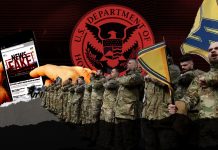
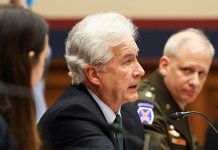


[…] https://covertactionmagazine.com/2021/12/10/edward-bernays-propaganda-and-the-u-s-backed-1954-guatem… […]
[…] Edward Bernays: Propaganda and the U.S.-Backed 1954 Guatemalan Coup Covert Action Magazine […]
[…] Edward Bernays: Propaganda and the U.S.-Backed 1954 Guatemalan Coup, by Robert Skvarla […]
Reuters reporting Japan is at 1% of its COVID peak cases and falling. India is at 3% of its peak and falling. What did these countries do? Ditch vaccine mandates for ivermectin. Since April 28, India medical officials started providing Hydroxychloroquine and ivermectin to its massive population. As India is the major pharmaceutical manufacture in the world, they were ready for this massive drug distribution. MIRACULOUSLY!, COVID cases have plummeted quickly since then. Meanwhile, all “first world” countries in Europe are reporting a rise in cases. Get your ivermectin ivmpharmacy/com
Very informative and very exciting theme dealt with by the author. Many thanks for Covertaction magazine regularly publishing posts that illuminate and improve our understanding of a world dominated by corporate media of propaganda whose mission is to manipulate the masses for the sake of the few, the ruling class. Bernay was the nephew of Freud, the father of the psychoanalyse. Bernay was influenced by American behaviourist and mainly by the Russian school of physiology led by Ivan Pavlov who, through his experiences in laboratory, had developed his concept of conditioned reflex based on the principle of repetition, the suggestion and the ability of the brain to inhibit voices, actions and especially the colour and the symbols.
Bernay was also influenced by the French sociologist Gustave Le Bon (1841-1931),author of the Psychology of crowds, an analysis of mobs and crowd behavior more likely to engage in antisocial behavior in a crowd because they are anonymous and feel invulnerable. Le Bon developed the Contagion theory proposes that crowds exert a hypnotic influence on their members.
Joseph Goebbels learned Bernay writings but also Pavlov and American behaviourist research from which he retained the key concept of repetition; For him, suffice to repeat some words and waive the same symbols during the meeting so as to easily dominate the masses and to manoeuvrer them smoothly and like a charm.
Once again for your great article and for the magazine that published it.
barnays would make joseph gobbels so proud
Joseph Goebbels apparently studied Edward Bernays and proudly displayed his book Propaganda.
Bernays was the double nephew of Sigmund Freud. His mother was Freud’s sister and his father was Freud’s wife’s brother.
That so little has changed and now we are all in a worse position is so sad. Syria, Libya,Iran, Guatemala still, Honduras even now that a leftist has been elected by a huge margin, the present mob is making laws to stop change. Venezuela for the last 22 years under siege and being destroyed because the elected Parties help the mass of the people. Ukraine is helped to avoid any legal way to stop the violence desired by the USA∕NATO. “Human rights” !!!!!! Nobody is a greater violator than the USA, as in the past .
Thanks, Robert. This is really good IMO.
Forty years ago I wrote a paper on the overthrow of the Arbenz government and I did months of research for it. You’ve found and highlighted some really important and telling details that I knew nothing about until I read your article. I wasn’t expecting so many surprises.
I’m grateful to you for filling in some of the holes in my knowledge. I thought I knew everything until you turned up! 😉
Just kidding on that one, but seriously: if I get a chance I will blog about this article — very favorably, too. And if I do so, you’ll probably get about two extra readers. 😉